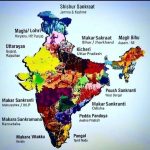Happy Makar Sankranti, Lohri, Bihu, Pongal, Villaku, Uttarayan.

After the winter solstice on December 21st, from the northern hemisphere, the sun is viewed at the Tropic of Capricorn. This is its furthest declination south during its ecliptic. During this period, it is the height of winter in the temperate zone north of the equator and the days are very short. This is usually around the Yuletide season. Yule is a Germanic winter solstice festival, akin to the Roman festival Saturnalia. This now been adopted as Christmas in the Gregorian calendar. The premise of celebration, however, the same in all other winter solstice traditions. It is a tradition centered around the sun as a form of the Divine with wishes of longer warmer days at the end of winter.

After the winter solstice, the sun’s declination starts moving to the north pole and the days being noticeably longer again. Around January 14th, the sun. as a celestial body, transits through the zodiac sign of Capricorn on its northward trek. In Sanskrit “Makar”, literally meaning crocodile, is the zodiac term for Capricorn and “Sankranti” means transit. This is a significant point for many civilizations as it also signals the end of winter and the beginning of spring.

In T&T the current period marks the harvest season. This would be familiar to many of us who remember the days of the sugarcane fields. The recent drop in our temperature, to below 25 degrees Celsius, is a tell-tale sign of this. For Hindu Indo-Trinidadians, this change in atmosphere was a classic sign that Makar Sankranti. Hindus worship the sun thanking his influence on the harvest bounty. For Roman Catholics, in T&T this date closely coincides with the Epiphanytide or the Epiphany season that begins on January 6th, the day after the 12 days of Yuletide or Christmastide has ended. Epiphany day Western Christianity is a feast that celebrates the visit to the Christ child by the Three Wise Men or Three Kings. Our French and Spanish traditions celebrate this as Three Kings Day. This day precedes Ash Wednesday or the start of the Lent (Spring) fast, 40 days before Easter or the height of spring.

India and its diaspora are one of the only civilizations that continue to practice this ancient tradition. It is an observation based on the solar cycles while most religious festivals are based on the lunar cycle. Thus, this festival is carded on the same date on the Gregorian calendar every year, January 14th/15th.

Today in the Indo-Caribbean world this festival is still celebrated by the various sects of Hinduism that came with the Indian indentured laborers. The major sect of Santana Dharma celebrates its as Makar Sankranti. However, we go to the French Antilles, we see the South Indian or Tamil festival of Pongal, known as Thai Pongal in India. It is observed at the start of the month of Thai according to the Tamil Hindu solar calendar. Again, this is also a harvest festival thanking the sun for his blessings on the bounty of the harvest.

In Bollywood films, we see this festival as Lohri in the Sikh and Hindu Punjabi tradition. Many local Hindus often take a pilgrimage to the Kumbh Mela in India at the time of Makar Sankranti. These may be the few festivities of Makar Sankranti that we are exposed to here in T&T based on the media. However, Makar Sankranti is celebrated in a myriad of ways over the subcontinent of India as social festivities such as colorful decorations, rural children going house to house, singing and asking for treats in some areas, melas (fairs), dances, kite flying, bonfires, and feasts.
The more we look into the roots of the celebrations of spring, the more and more we realize how these geographic and climate-specific traditions have added to our unique identity here in T&T.

Credits To Dr. Visham Bhimull
Founder of Caribbean Hindustani
Donate
Please consider Donating to keep our culture alive



Leave a Reply
You must be logged in to post a comment.